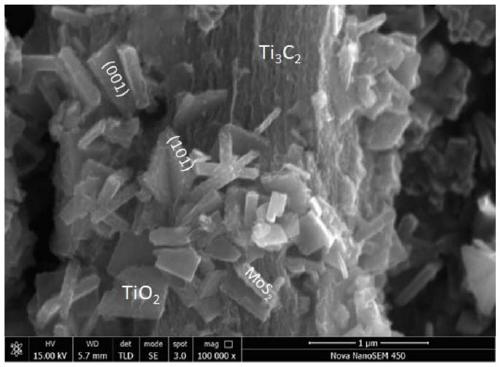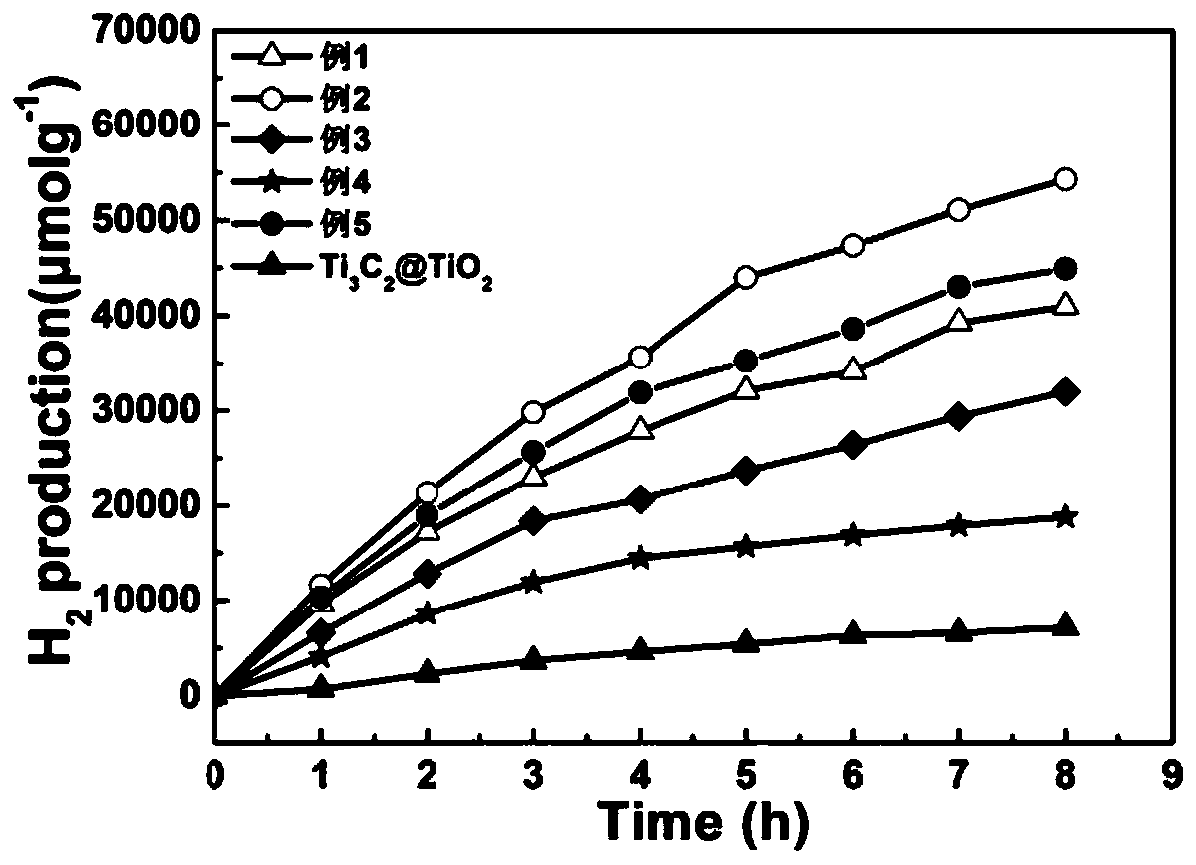Titanium carbide sheet layer/molybdenum sulfide nanosheet/titanium dioxide nanosheet composite and preparing method thereof
A technology of titanium dioxide and composite materials, which can be used in catalyst activation/preparation, chemical instruments and methods, nanotechnology, etc., and can solve the problems of high price and low output.
- Summary
- Abstract
- Description
- Claims
- Application Information
AI Technical Summary
Problems solved by technology
Method used
Image
Examples
Embodiment 1
[0032] First measure 100 milliliters of hydrofluoric acid solution with a mass ratio of 40%, weigh 1 gram of titanium-aluminum-carbon powder, the particle size of the titanium-aluminum-carbon powder is 200 mesh, and fully mix the hydrofluoric acid solution and the titanium-aluminum-carbon powder Stir at room temperature for 72 hours to prepare the first mixed solution. Then filter the first mixed solution, add 100 mg of titanium carbide and 10 mg of sodium fluoroborate to 10 ml of 0.1 mole per liter hydrochloric acid solution and magnetically stir for 30 minutes to prepare the second mixed solution. Then, the second mixed solution was placed in a hydrothermal reaction kettle, and subjected to a hydrothermal reaction at 160° C. for 12 hours to prepare a third mixed solution. Then filter the third mixed solution to obtain the precipitate titanium carbide / titanium dioxide nanosheet composite material, add 60 mg of precipitate titanium carbide / titanium dioxide nanosheet composite ...
Embodiment 2
[0035] First measure 100 milliliters of hydrofluoric acid solution with a mass ratio of 40%, weigh 1 gram of titanium-aluminum-carbon powder, the particle size of the titanium-aluminum-carbon powder is 200 mesh, and fully mix the hydrofluoric acid solution and the titanium-aluminum-carbon powder Stir at room temperature for 72 hours to prepare the first mixed solution. Then filter the first mixed solution, add 100 mg of titanium carbide and 10 mg of sodium fluoroborate to 10 ml of 0.1 mole per liter hydrochloric acid solution and magnetically stir for 30 minutes to prepare the second mixed solution. Then, the second mixed solution was placed in a hydrothermal reaction kettle, and subjected to a hydrothermal reaction at 160° C. for 12 hours to prepare a third mixed solution. Then filter the third mixed solution to obtain the precipitate titanium carbide / titanium dioxide nanosheet composite material, add 60 mg of precipitate titanium carbide / titanium dioxide nanosheet composite ...
Embodiment 3
[0039] First measure 100 milliliters of hydrofluoric acid solution with a mass ratio of 40%, weigh 1 gram of titanium-aluminum-carbon powder, the particle size of the titanium-aluminum-carbon powder is 200 mesh, and fully mix the hydrofluoric acid solution and the titanium-aluminum-carbon powder Stir at room temperature for 72 hours to prepare the first mixed solution. Then filter the first mixed solution, add 100 mg of titanium carbide and 10 mg of sodium fluoroborate to 10 ml of 0.1 mole per liter hydrochloric acid solution and magnetically stir for 30 minutes to prepare the second mixed solution. Then, the second mixed solution was placed in a hydrothermal reaction kettle, and subjected to a hydrothermal reaction at 160° C. for 12 hours to prepare a third mixed solution. Then filter the third mixed solution to obtain the precipitate titanium carbide / titanium dioxide nanosheet composite material, add 60 mg of precipitate titanium carbide / titanium dioxide nanosheet composite ...
PUM
 Login to View More
Login to View More Abstract
Description
Claims
Application Information
 Login to View More
Login to View More - R&D
- Intellectual Property
- Life Sciences
- Materials
- Tech Scout
- Unparalleled Data Quality
- Higher Quality Content
- 60% Fewer Hallucinations
Browse by: Latest US Patents, China's latest patents, Technical Efficacy Thesaurus, Application Domain, Technology Topic, Popular Technical Reports.
© 2025 PatSnap. All rights reserved.Legal|Privacy policy|Modern Slavery Act Transparency Statement|Sitemap|About US| Contact US: help@patsnap.com



